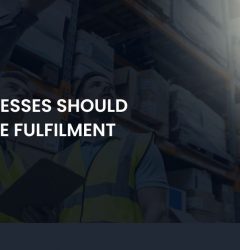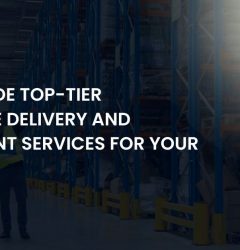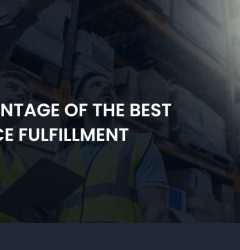01 Jul
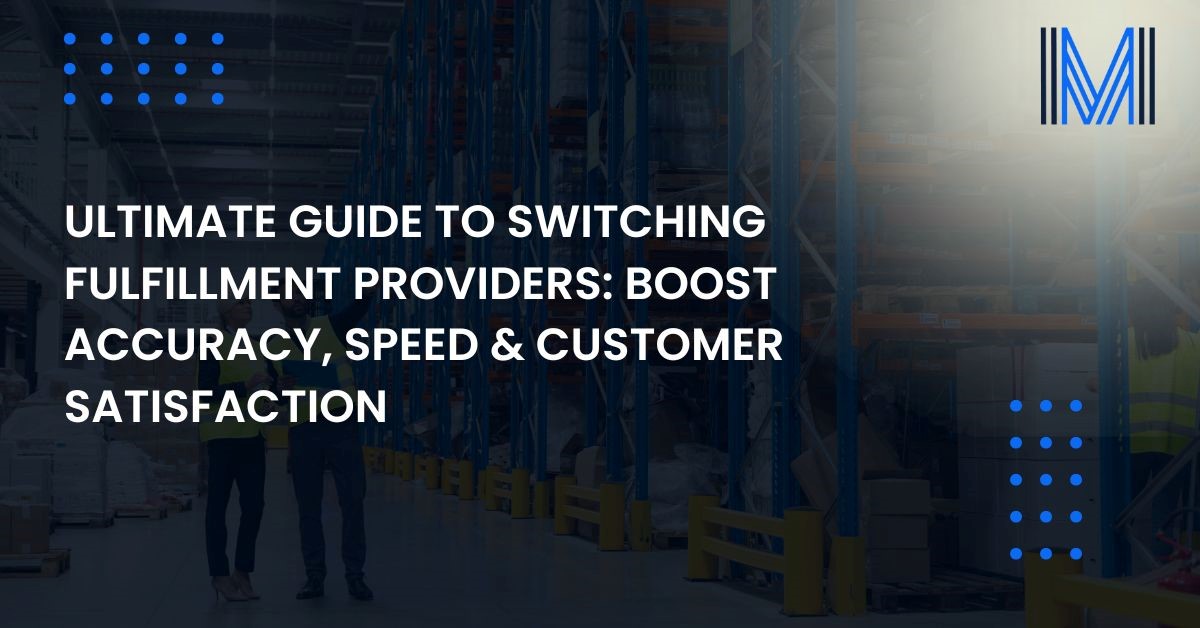
At some point, fast-growing brands begin to feel the strain of an inefficient 3PL (Third-Party Logistics). When late deliveries become the norm and operational costs continue to rise, the fulfillment provider that once worked may now be holding your business back. This is when switching fulfillment provider becomes less of a consideration and more of a necessity.
Industry research indicates that 73% of consumers expect fast delivery, and nearly 69% will avoid returning to a brand after experiencing just one poor delivery. These expectations make fulfillment performance a key factor for success.
A transition to new 3PL services offers brands a path toward fewer errors, faster delivery speeds, and better customer relationships. In the sections ahead, discover what signs to watch for, how to plan the switch effectively, and what makes a successful fulfillment process in today’s ecommerce environment.
Signs You Need to Switch Your Fulfillment Provider
Recognizing early signs of inefficiency or misalignment can save time, revenue, and customer trust.
Metrics-Based Signs
- An increase in order errors or returns
- Frequent failure to meet SLAs
- Fulfillment costs climbing without improvement
- Declining accuracy in order processing
Operational Indicators
- Systems that do not integrate easily with your ecommerce platforms
- Difficulty scaling during peak times or sales periods
- Inventory data that is not reliable or lacks real-time visibility
Customer-Impact Indicators
- Growing delays in shipping timelines
- Negative reviews related to late or incorrect deliveries
- Consistent breakdowns in customer order continuity
These patterns often point to deeper issues and represent key signs your fulfillment process needs improvement.
What Defines a Successful Fulfillment Process
Making a switch is not only about fixing what is broken. It also presents the opportunity to build a better model from the ground up.
These are the key components of a reliable and successful fulfillment process:
- Order accuracy consistently above 99%
- Real-time tracking for both inventory and shipments
- Automation in picking and packing
- Reporting tools that allow you to monitor operations clearly
- Dependable shipping through multiple carriers
All of these elements contribute directly to improving customer satisfaction through better fulfillment, building brand trust and loyalty over time.
Planning Your Transition to a New 3PL
When approaching a transition to new 3PL, structure and foresight can make the process smooth and effective.
Phase 1: Strategic Preparation
- Review the current provider’s service levels
- Analyze the contract and any fulfillment contract termination clauses
- Build in financial coverage for temporary dual operations during the switch
Phase 2: Operational Readiness
- Unify and clean up product and shipping data
- Confirm that your ecommerce platforms, WMS, and ERP are ready for integration
Phase 3: Timing & Communication
- Time the transition during low order volume months
- Provide internal teams with rollout updates and messaging
- Notify customers in advance of any changes that could affect delivery
This structured approach limits disruption and reduces the risk involved in changing 3PL services.
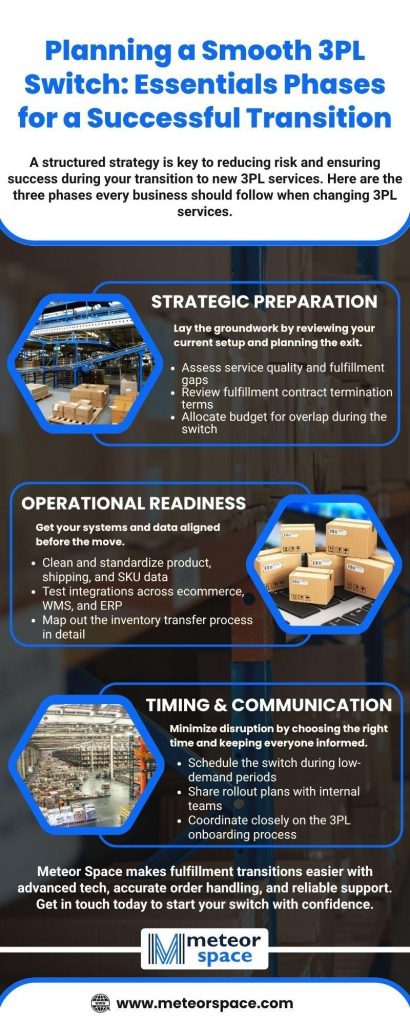
Execute the Switch: From Inventory Move to Going Live
The success of a switching fulfillment provider project depends on the strength of your execution plan. This includes:
Inventory Logistics
- Schedule warehouse transfers in stages
- Allocate time for physical SKU checks and accurate labelling
- Track inventory movements carefully during the inventory transfer process
Running a Pilot
- Send a small set of orders through the new system
- Monitor speed, accuracy, and delivery consistency
- Review how data syncs in real time across platforms
Training Teams
- Provide your team with direct onboarding for dashboards and systems
- Collaborate closely with the new provider’s 3PL onboarding process
How to Deliver Orders Faster and More Accurately
Meeting rising customer expectations requires deliberate investment in technology and fulfillment strategy. Here are key tips to boost fulfillment accuracy and shipping speed:
- Store inventory in fulfillment centers located near major customer clusters
- Automate repetitive tasks using scanning, batch picking, and routing logic
- Eliminate manual errors by streamlining order flows
- Use routing tools to assign orders to the most efficient warehouse
The results will be evident in delivery reviews, repeat purchases, and operational savings.
Post-Launch: Optimize & Monitor Fulfillment Performance
Switching fulfillment providers is not the final step and requires continuous checks and improvements.
- Track the right KPIs: on-time delivery, cost per order, and order accuracy
- Use cloud-based dashboards to gather live data
- Conduct quarterly reviews to refine and improve service
- Build processes to reduce risk and improve visibility in every part of the supply chain
Understanding how to track warehouse performance effectively is critical to long-term success in fulfillment operations.
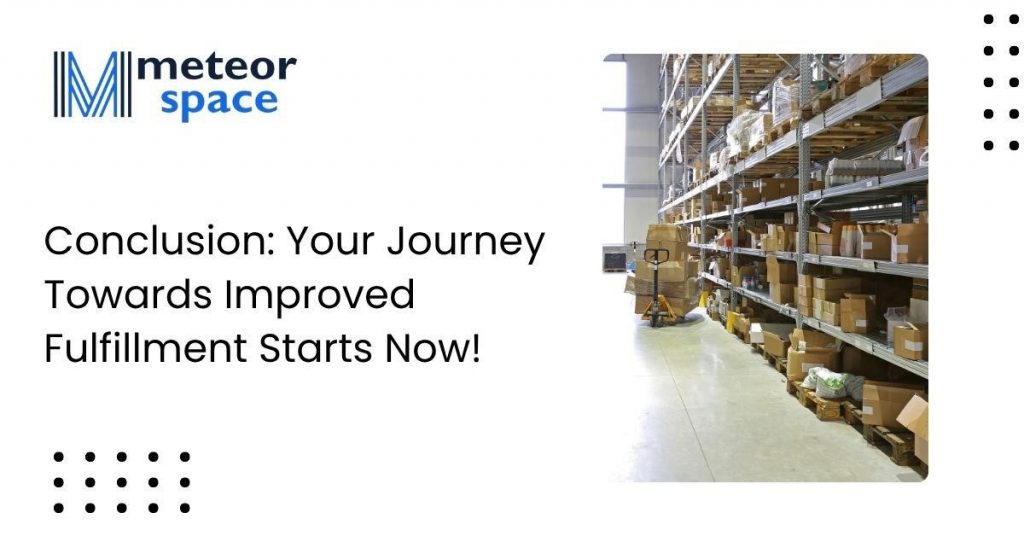
Conclusion: Your Journey Towards Improved Fulfillment Starts Now!
Switching order fulfillment provider is a game-changing decision that can unlock faster shipping, improved accuracy, and better customer satisfaction. Businesses that take action before fulfillment challenges grow too large position themselves for faster growth and smoother operations.
Meteor Space supports this journey from planning to execution. Operating from a 250,000 sq ft facility in Northern Ireland, we deliver advanced warehouse automation, real-time inventory tracking, and high-speed DTC fulfillment across the UK and Europe. Our team specializes in custom pick and pack services tailored to help retailers deliver efficiently at scale.
Looking to upgrade your logistics strategy? Let Meteor Space show you how to simplify your fulfillment model and focus more on what drives your business forward.
FAQs
1. How long does switching to a new fulfillment provider take?
Most transitions take between two to six weeks. That depends on inventory size, technology integration, and how much overlap is planned with your existing provider.
2. Will my customers experience delays during the transition?
Delays can be avoided through a buffer period and test orders. A pilot phase also reduces the risk of disruptions to customer deliveries.
3. How do I sync inventory and order data between systems?
A modern 3PL will offer platform integrations that allow inventory, order, and tracking data to update automatically across systems. Clear data structure and early testing help maintain system accuracy.
Author:
Namrata Chawla
Namrata Chawla, a professional writer, crafts compelling weblog content on warehouse management, inventory control, logistics, and beyond. With a wealth of experience in this niche, she’s dedicated to delivering unique, informative, and top-tier posts. Her commitment to exploration ensures fresh perspectives in each insightful blog post.
UPDATED ON: 1st July 2025

